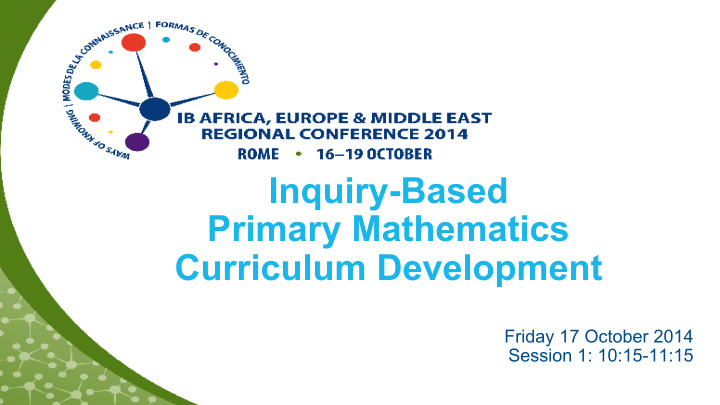



Inquiry-Based Primary Mathematics Curriculum Development Friday 17 October 2014 Session 1: 10:15-11:15
Vienna International School Vienna, Austria Dr. Christine Orkisz Lang Primary School Maths Coach Grade Two Teacher Anika Sommer Grade Level Leader Grade Five Teacher
School Goal: Whole School Curriculum Ages 3-18 T imeline: 2011-12: Parent community survey, teacher survey 2012-13: Cross School committee + Steering Groups to identify needs 2012-2013: Review of other Maths curricula 2013-14: New curriculum documentation creation 2014-15 Implementation Phase 1 (End of year review) 2015-2020: Implementation Phase 2
Reasons for a New Programme • New powerful technologies to support learning available • Extensive advances made in the field of pedagogy, particularly research into the brain and how it works • Acknowledgement that genuine learning takes place in situations which are authentic and this was not reflected in previous curriculum • A need for increased detail and training for teachers who are not Maths specialists was identified
Discussion Questions #1 1) Where is your school with regard to curriculum review and implementation in mathematics? 2) Which of the 5 reasons provided here for designing a new programme seems most important to you? (technology, brain-based research, authentic experiences, detail/training for teachers, whole school articulation)
Goals of the New Programme 1. Rigorous, developmentally appropriate learning 1. Emphasis on communication in Mathematics 2. Emphasis on Mathematical processes: ways of working 3. Focus areas to allow for depth of study
Resources Used 1. VIS previous Scope & Sequence 2. First Steps (Government of Western Australia) 3. Ontario Province Curriculum 4. National Council of Teachers of Mathematics (NCTM) 5. New Zealand National Curriculum 6. John Van der Walle
Other Input • Christine Lyons, M.Ed., PhD • CEO, Dragonfly Educational Consulting Services, Inc. • Expertise • Training • Validation
Two Documents ● ELC-Grade 5 Mathematics Programme ● Calculation Policy and Practices Document
Maths Content Strands (PYP) Number - all grade levels + all substrands Pattern and Function - all grade levels Data Handling - all grade levels, SOME substrands Shape and Spaces - focus grades Measurement - focus grades
Number Understand Whole Understand Operations and Decimal Numbers Understand Fractional Calculate Numbers 8 key 10 key understandings understandings 7 key 10 key understandings understandings
Pattern and Function Reason About Number Patterns 6 key understandings
Measurement Understand Units Estimation Direct Measure Indirect Measure 8 key 3 key understandings understandings 6 key 4 key understandings understandings
Shape and Space Represent Location Reason Geometrically Represent Represent Shape Transformation 3 key 4 key understandings understandings 3 key 4 key understandings understandings
Data Handling Understand Chance Interpret Data Collect and Process Data Collect and Process Data (Part B) (Part A) 7 key 3 key understandings understandings 5 key 6 key understandings understandings
Focus Overview
Strands broken into sub strands Focus or big idea for that grade and that substrand KUs from First Steps Resources Coded bullet to Indicating point you to behaviours, not other documents outcomes
Problem Type Overview
Vocabulary Overview
Calculator Use Overview
Calculation Policy and Practices ● Divided into the four operations ● Each operation split into two sections: - mental calculation - written calculation
Calculation Policy and Practices: Overview The big ideas for calculation in each grade
Calculation Policy and Practices: cont’d End of grade expectations
Calculation Policy and Practices: cont’d d e e r g a n ’ S e I t V t i r w l a m f o r o d f o h t r e o m f n o i t a n l u o c i t a l a r c e p o h c a e
Calculation Policy and Practices: cont’d Aspects of knowledge to expect and revise from the previous year
Glossary Mathematical vocabulary that will help US and students ESL teachers, we need your help!
Discussion Questions #2 1) What are your first impressions of the components and structure of the curriculum? 2) What questions do you have about the components and structure of the curriculum?
How can we make this work? What are our Ways of Knowing that it is working? New Curriculum ≠ ¡Improved ¡Learning ¡
‘Closed Circle’ The program is supported by: ● Maths Coach ● Parent Partnerships ● Ongoing teacher training
Year Planning
Mid-Range Planning + Inquiry Cycles
From Formative Assessment to Differentiated Teaching
Summative Assessment • InCas standardised testing (new) • ISA standardised testing • Repeat of Diagnostic Tasks • Trial of VIS Numeracy Assessment (emphasising practices <-> MYP) • Teacher-created assessments
Reporting
Discussion Questions #3 1) Do you feel that your mathematics programme has a ‘closed circle’ to support teachers? 2) If not, what might be a next step for you? If it does, what might you add to ours?
Comments and Questions
Dr. Christine Orkisz Lang clang@vis.ac.at Anika Sommer asommer@vis.ac.at
Recommend
More recommend